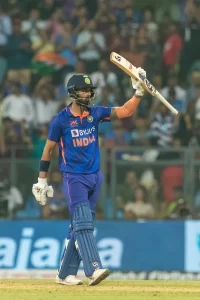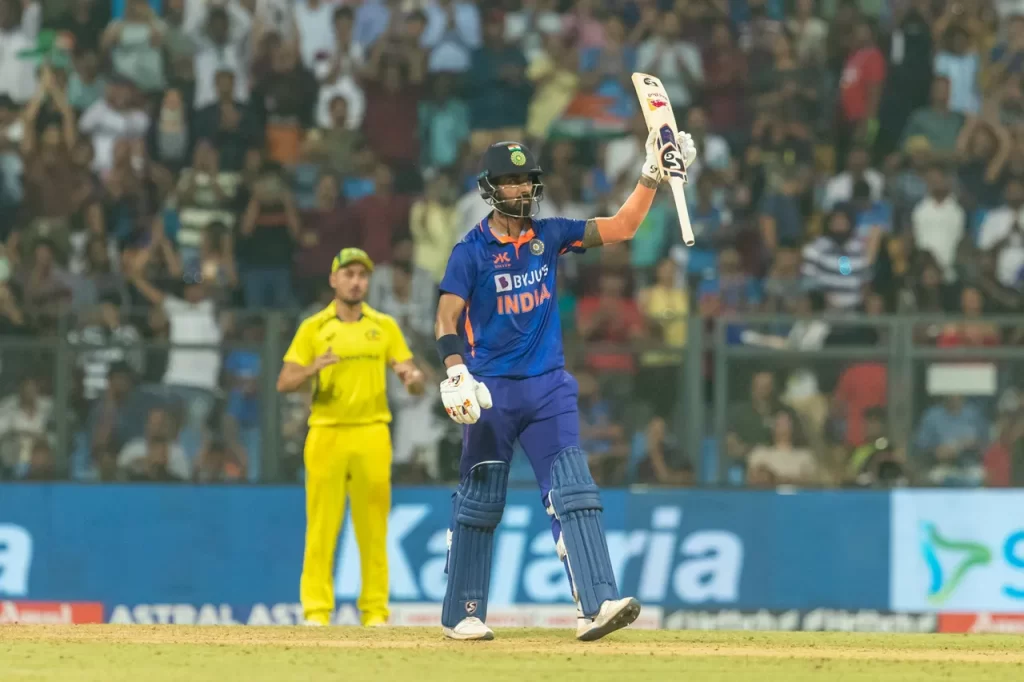
He has been a lightning rod for criticism of the Indian team in recent times, and has lost his Test place, but KL Rahul showed in a low-scoring game just how important he could be to India’s hopes of winning the World Cup on home soil.
It’s fair to say that KL Rahul has stayed in Indian cricket’s short-term plans because of his ODI form on Indian pitches. A lot of players suffered form slumps in the aftermath of the Covid-19 pandemic, unable to get to grips with bubble life, quarantine periods and isolation from friends and family. Rahul, however, seemed to be impacted worse than most. His Test and T20I form plummeted, and it isn’t a stretch to say that he might have been out of the picture altogether if not for India hosting the World Cup later this year.
Just look at the numbers. He averages 30.28 across 11 Test over the past three years (two centuries) and 28.71 from 30 T20Is. In both formats, the average and strike-rate are well down on what they were before 2020. It’s only in the 50-over arena that he has managed to hold his own, and there too the numbers are very skewed.
An average of 43.87 and a strike-rate of 87 from 20 matches looks impressive, until you see that the average drops to 26.81 away from home (11 innings). In eight innings in India, he scores at an average of 81.40 and a strike-rate of 90.64. Though India have experimented with different openers alongside Rohit Sharma, Rahul’s ability to keep wicket and bat anywhere in the top or middle order makes him a valuable option.
If you went only by what you read on social media, you’d think Rahul had somehow blackmailed the team management to keep his place, that he was some undeserving, good-for-nothing cricketer. Remember that this is a 30 year old who was just the third Indian, after Suresh Raina and Rohit Sharma, to score a century in each of the three formats. He has Test centuries at Lord’s, the Melboune Cricket Ground and the South African fortress at Centurion. Only Rohit and Suryakumar Yadav have more T20I centuries for India than he does. A lot of us would give much to be that ‘useless’.
Rahul has never been arrogant, or been involved in any unsightly on-field controversies. He trains and practises hard, and is a valued teammate by all accounts. If various players and Rahul Dravid, the coach, came out in support of him over the past few months, it was only because they’re better aware of his ability than armchair critics.
Still, no team is so insulated from the real world that it can shut out avalanches of criticism. It wasn’t just his poor run with the bat in Tests that eventually cost Rahul his place in the XI during the recent series against Australia. It was also the concerted noise on social media in favour of bringing in Shubman Gill, the youngster widely regarded as Indian cricket’s future batting great.
At the Wankhede Stadium on March 17 – 16 years to the day after one of Indian cricket’s darkest hours, the World Cup loss to Bangladesh in Trinidad – Rahul walked in at 16 for 3, effectively tasked with the opener’s job, as the ball was only five overs old. That soon became 39 for 4, and then 83 for 5.
The way he batted India out of trouble, you wouldn’t have guessed how tough recent weeks and months have been on him. There was one stroke in particular, when Mitchell Starc, who had wrecked the Indian top order, returned for a second spell. He opened with a yorker speared in at the stumps. Rahul, as though he had been in prime form for month, played it as late as possible, deflecting the ball off the full face of the bat down to third man.
One match-winning innings won’t turn the tide for Rahul. In some ways, he has become the lightning rod for criticism of the team. But after a lean patch, this will definitely help, especially as India build towards a home World Cup, hoping to emulate the triumphs of 1983 and 2011.
What both those teams had was batting depth, and a variety of characters capable of playing crucial innings. Kapil Dev’s team, apart from his own incredible hitting, had the guts of Mohinder Amarnath and Yashpal Sharma, and the attacking intent of Sandeep Patil. Syed Kirmani, Kirti Azad and Roger Binny too chipped in when needed.
When MS Dhoni’s side won a generation later, the brilliance of Yuvraj Singh and Sachin Tendulkar was backed up by blazing hundreds from Virender Sehwag and Virat Kohli, and Suresh Raina making two of the most important 30s in the history of the game – in the quarterfinal against Australia and the semifinal against Pakistan. Gautam Gambhir set up the run chase in the final with an unforgettable 97, and Dhoni, who had done next to nothing with the bat till then, finished things off with his unbeaten 91.
To win a World Cup, you need those kind of contributions across the board. In that context, this win, without Rohit and with Kohli contributing just four runs, was very important. A chase of 189 in Indian conditions is usually a stroll in the park. But on this pitch, with plenty on offer for the pace bowlers in particular, it definitely wasn’t straightforward. Ravindra Jadeja played his part with the bat, but it was Rahul that was instrumental in getting the team home. That it was so comfortable in the end shouldn’t obscure how hard it was for the first 20 overs.
Teams spend the four years between World Cups usually tinkering with new players and combinations. It’s only in the last six months that they tend to settle on a template that they feel will win them the trophy. In Mumbai, in the most challenging conditions, Rahul showed that he’s certainly going to be part of those plans.




